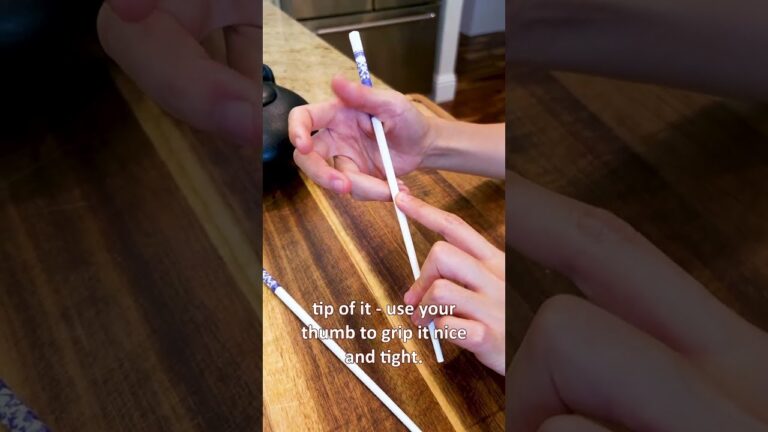[ad_1]
Okay, let’s learn how to use chopsticks! Here’s a detailed guide:
I. Understanding the Anatomy of Chopsticks
- Tapered End: The end you use to pick up food. Ideally, these ends should be rounded or textured for better grip.
- Blunt/Wider End: The end you hold.
- Upper Chopstick (Active Chopstick): The one you move.
- Lower Chopstick (Resting Chopstick): The one that remains stationary.
II. The Proper Grip
-
Positioning the Resting Chopstick:
- Hold one chopstick (the resting chopstick) about one-third of the way down from the blunt end.
- Rest the wider end on the web between your thumb and index finger.
- The chopstick should rest along the base of your ring finger. Your ring finger, and the tip of your middle finger help support it.
- It should feel stable and secure, but not tightly gripped.
- This chopstick DOES NOT MOVE during eating.
-
Positioning the Active Chopstick:
- Hold the second chopstick (the active chopstick) like you would hold a pen or pencil.
- Grip it with your thumb, index finger, and middle finger.
- The blunt end should be above the resting chopstick.
- Movement:
- The upper (active) chopstick is the only one that should move.
- Move it up and down by flexing your index and middle fingers. The lower (resting) chopstick remains still.
- Practice opening and closing the chopsticks to get a feel for the movement.
III. Picking Up Food
- Practice with Larger Items:
- Start with larger, easier-to-grab items like tofu cubes or large pieces of vegetables.
- Aligning the Chopsticks:
- Bring the tips of the chopsticks together.
- Ensure they are aligned to create a firm grip.
- Grip the Food:
- Squeeze the chopsticks together to firmly grip the food item.
- Lifting the Food:
- Lift the food slowly and deliberately.
- Avoid squeezing too hard, which can cause the food to slip or break.
IV. Common Mistakes and How to Avoid Them
- Crossing Chopsticks: Avoid crossing chopsticks, especially when placing them on a resting surface. This is considered bad luck and disrespectful in many Asian cultures.
- Sticking Chopsticks Upright in Food: Never stick your chopsticks vertically into a bowl of rice or other food. This resembles incense sticks offered to the deceased and is a major cultural faux pas.
- Waving Chopsticks Around: Avoid waving chopsticks in the air or using them to point at people or things.
- Spearing Food: Do not spear food with your chopsticks unless it’s extremely difficult to pick up otherwise (and even then, try to avoid it).
- Licking Chopsticks: It is considered impolite to lick your chopsticks.
- Holding Chopsticks Too Low: Holding the active chopstick too close to the tips makes it harder to maneuver.
- Gripping Too Tightly: A death grip will make your hand tire quickly and reduce dexterity.
- Using Mismatched Chopsticks: When eating with others, use a matching pair of chopsticks.
- Using Chopsticks as Drumsticks: Avoid tapping your chopsticks on the table or bowl.
- Digging or Rummaging: Don’t dig around in the dishes to find something specific you want.
V. Resting Chopsticks
- When not in use, rest your chopsticks on a chopstick rest (if provided).
- If there is no rest, you can rest them horizontally across the edge of your bowl or on the table. Ensure the tips don’t touch the table.
VI. Types of Chopsticks
- Wooden: Common, inexpensive, and often disposable. Can be textured for better grip.
- Bamboo: Lightweight and sustainable.
- Plastic: Durable and reusable, often found in restaurants.
- Metal: Usually stainless steel, common in Korean cuisine. Can be slippery.
- Lacquered: Often decorative and used for special occasions.
VII. Etiquette Considerations
- Offer food to others: It’s polite to offer food to your companions, especially elders, using your chopsticks. Turn your chopsticks around to use the clean, unused ends to transfer the food.
- Take only what you will eat: Avoid taking large portions that you cannot finish.
- Be mindful of shared dishes: When taking food from a shared dish, try to take the piece closest to you.
- Watch and learn: Observe how others use chopsticks and adapt your technique accordingly.
VIII. Practice Tips
- Start with dry foods: Dry foods like crackers or pretzels are easier to pick up than slippery foods like noodles.
- Use different sizes and textures: Experiment with different food items to improve your dexterity.
- Practice regularly: The more you practice, the more comfortable and natural using chopsticks will become.
- Don’t be afraid to ask for help: If you’re struggling, don’t hesitate to ask someone for assistance. Most people are happy to offer guidance.
- Be patient: It takes time and practice to master using chopsticks. Don’t get discouraged if you don’t get it right away.
IX. Advanced Techniques (Optional)
- Peeling food: Using chopsticks to peel shrimp or other food items.
- Cutting food: Using the edges of the chopsticks to cut softer foods.
- Stirring: Using chopsticks to stir your food in a bowl.
X. Cleaning Chopsticks
- Wash reusable chopsticks thoroughly with soap and water after each use.
- Ensure they are completely dry before storing them.
Good luck, and happy eating!
[ad_2]

